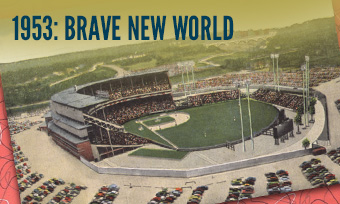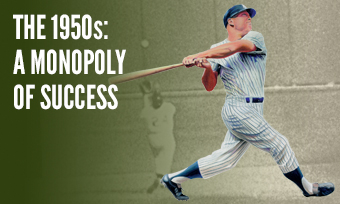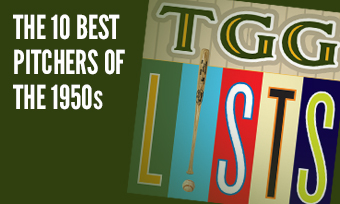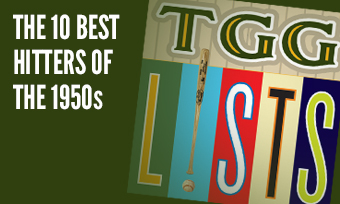The Yearly Reader
Leaders and Honors, 1953
Our list of baseball’s top 10 hitters and pitchers in both the American League and National League for the 1953 baseball season, as well as the awards and honors given to the game’s top achievers of the year.
The National League’s Top 10 Hitters, 1953
Bold type in brick red indicates league leader.
1. Duke Snider, Brooklyn
Key Numbers: 154 games, .336 average, 132 runs, 198 hits, 38 doubles, 42 home runs, 126 RBIs, 82 walks, 16 stolen bases, .627 slugging percentage.
Whether it was because he stung lefties more, was protected by a gang of right-handed slugging stars, or that he was just simply getting better, Snider emerged into a monster force with the first of five straight years with 40-plus homers.
2. Stan Musial, St. Louis
Key Numbers: .337 average, 127 runs, 200 hits, 53 doubles, 9 triples, 30 home runs, 113 RBIs, 105 walks, .437 on-base percentage.
Stan the Man may have failed in his quest to cop a fourth straight batting title, but it wasn’t for a lack of a last-ditch effort—hitting .429 over his final 32 games.
3. Eddie Mathews, Milwaukee
Key Numbers: .302 average, 110 runs, 175 hits, 31 doubles, 8 triples, 47 home runs, 135 RBIs, 99 walks, 16 intentional walks.
The breakout slugger, along with his Braves teammates, reveled in the reception from eager new fans in Milwaukee—but on the road, he was even more at home, hitting .343 with 30 homers away from County Stadium.
4. Roy Campanella, Brooklyn
Key Numbers: .312 average, 103 runs, 162 hits, 26 doubles, 41 home runs, 142 RBIs.
Campanella was at his thunderous best while winning his second of three MVPs, driving in five-plus runs five times.
5. Gil Hodges, Brooklyn
Key Numbers: .302 average, 101 runs, 157 hits, 22 doubles, 7 triples, 31 home runs, 122 RBIs, 75 walks.
Hodges hit over .300 for the first of two straight seasons—the only two in which he’d finish over the milestone—even after a poor start in which he was mired in the .100s as late as May 25.
6. Jackie Robinson, Brooklyn
Key Numbers: .329 average, 109 runs, 159 hits, 34 doubles, 7 triples, 12 home runs, 95 RBIs, 74 walks, 17 stolen bases.
A man of all positions in 1953, Robinson played all four infield spots and, for the first time, in the outfield as he obliged promising rookie Jim Gilliam to take his normal place at second base.
7. Ted Kluszewski, Cincinnati
Key Numbers: .316 average, 97 runs, 180 hits, 25 doubles, 40 home runs, 108 RBIs.
All biceps and no sleeves, the muscular Kluszewski took advantage of a moved-in right-field wall in Cincinnati to become the first Red (er, Redleg) to reach 40 homers.
8. Carl Furillo, Brooklyn
Key Numbers: 132 games, .344 average, 82 runs, 165 hits, 38 doubles, 6 triples, 21 home runs, 92 RBIs.
Furillo hit .361 at Ebbets Field, helping the Dodgers to win a franchise-record 60 games out of 77 at the fabled ballpark.
9. Ralph Kiner, Pittsburgh-Chicago
Key Numbers: 158 games, .279 average, 100 runs, 157 hits, 35 home runs, 116 RBIs, 100 walks.
Kiner was unceremoniously exiled to Chicago after seven stellar seasons at Pittsburgh, because as Branch Rickey said: We finished last with you, and we’ll finish last without you.
10. Hank Thompson, New York
Key Numbers: 114 games, .302 average, 80 runs, 15 doubles, 8 triples, 24 home runs, 74 RBIs, 60 walks.
Five different Giants hit 20 or more homers, and Thompson would have been the sole guy at 30-plus had he not had to prove his way back into the starting lineup early in the year.
The American League’s Top 10 Hitters, 1953
1. Al Rosen, Cleveland
Key Numbers: .336 average, 115 runs, 201 hits, 27 doubles, 5 triples, 43 home runs, 145 RBIs, 85 walks, .613 slugging percentage.
Had the AL’s home run/RBI leader managed a hit in his final at-bat of the season instead of grounding out, he would have edged Mickey Vernon for the AL batting title by one-tenth of a point—and secured the triple crown along with it.
2. Mickey Vernon, Washington
Key Numbers: .337 average, 101 runs, 205 hits, 43 doubles, 11 triples, 15 home runs, 115 RBIs.
But Rosen grounded out, and the batting crown belonged to the 35-year-old Vernon—seven years after winning his first title. His efforts helped a D.C.-based team earn its last non-losing record before the Expos came to town 50 years later.
3. Ray Boone, Cleveland-Detroit
Key Numbers: 135 games, .296 average, 94 runs, 17 doubles, 8 triples, 26 home runs, 114 RBIs, 72 walks.
Struggling at shortstop, misdiagnosed as a leadoff hitter and booed by Cleveland fans, Boone got a welcome trade to Detroit and immensely raised his comfort level at third base while averaging nearly an RBI per game.
4. Mickey Mantle, New York
Key Numbers: 127 games, .295 average, 105 runs, 24 doubles, 21 home runs, 92 RBIs, 79 walks.
Although Mantle had yet to power up to his future career-best heights, he still had the year’s most memorable homer when he blasted one completely out of Washington’s cavernous Griffith Stadium.
5. Minnie Minoso, Chicago
Key Numbers: .313 average, 104 runs, 174 hits, 24 doubles, 8 triples, 15 home runs, 104 RBIs, 74 walks, 17 hit-by-pitches, 25 stolen bases, 16 caught stealing, 23 grounded into double plays.
With Eddie Robinson shuffled off to the A’s, Minoso became the default masher within the White Sox’ lineup—and he did a good job of playing one in July, belting nine of his 15 season homers during the month.
6. Gus Zernial, Philadelphia
Key Numbers: .284 average, 85 runs, 42 home runs, 108 RBIs, 11 intentional walks.
Passed up by Al Rosen in the season’s final week for what could have been his second AL home run crown, Zernial still finished the year leading all AL players in home runs (133) over the decade’s first four seasons.
7. Yogi Berra, New York
Key Numbers: 137 games, .296 average, 80 runs, 23 doubles, 5 triples, 27 home runs, 108 RBIs.
Though he didn’t win the AL MVP this year, Berra placed second—the fourth of seven consecutive years in which he finished no lower than fourth in the vote.
8. Larry Doby, Cleveland
Key Numbers: .263 average, 92 runs, 29 home runs, 102 RBIs, 96 walks, 121 strikeouts.
Doby’s .263 average may have been his lowest amid any of his full-time campaigns, but he was still potent enough to place ninth in the AL in OPS (on-base plus slugging percentages).
9. George Kell, Boston
Key Numbers: 134 games, .307 average, 41 doubles, 12 home runs, 73 RBIs.
In his one full-time year at Boston, Kell arguably proved to be the most dangerous Red Sock in the lineup until Ted Williams returned late in the season from Korean War duty.
10. Eddie Yost, Washington
Key Numbers: .277 average, 107 runs, 30 doubles, 7 triples, 9 home runs, 45 RBIs, 123 walks.
In a decade in which nobody in the majors would accrue more walks, Yost continued to get the most out of opposing pitchers exhausting their pitch counts trying to retire him.
The National League’s Top 10 Pitchers, 1953
1. Warren Spahn, Milwaukee
Key Numbers: 2.10 ERA, 23 wins, 7 losses, .767 win percentage, 32 starts, 24 complete games, 5 shutouts, 265.2 innings.
Of all of his many great years that resulted in 363 career wins, 1953 may have been the absolute stingiest in Spahn’s major league tenure.
2. Harvey Haddix, St. Louis
Key Numbers: 3.06 ERA, 20 wins, 9 losses, .690 win percentage, 33 starts, 6 shutouts, 253 innings, 21 grounded into double plays.
The rookie started out strong in St. Louis, setting a career high in wins and leading the NL with six shutouts.
3. Robin Roberts, Philadelphia
Key Numbers: 2.75 ERA, 23 wins, 16 losses, 44 appearances, 41 starts, 33 complete games, 5 shutouts, 346.2 innings, 61 walks, 11 intentional walks, 198 strikeouts, 31 grounded into double plays.
Roberts’ continued excellence included a streak of 28 straight complete games dating back to 1952.
4. Lew Burdette, Milwaukee
Key Numbers: 3.24 ERA, 15 wins, 5 losses, .750 win percentage, 8 saves, 46 appearances, 13 starts, 175 innings.
First-half reliever, second-half starter, Burdette was all quality as he poked into an injury-riddled rotation and established himself as a sidekick to Warren Spahn.
5. Carl Erskine, Brooklyn
Key Numbers: 3.54 ERA, 20 wins, 6 losses, .769 win percentage, 39 appearances, 33 starts, 246.2 innings, 187 strikeouts.
Erskine was in line with Dodger dominance in the standings, posting the NL’s best win percentage while Brooklyn set a franchise record for the same.
6. Curt Simmons, Philadelphia
Key Numbers: 3.21 ERA, 16 wins, 13 losses, 30 starts, 238 innings.
When Robin Roberts needed a well-deserved breather, Simmons continued to step in as the next best guy as in the Phillies’ rotation.
7. Bob Buhl, Milwaukee
Key Numbers: 2.97 ERA, 13 wins, 8 losses, 30 appearances, 18 starts, 154.1 innings.
The rookie righty bounced around the bullpen until the Braves gave him shot at the rotation—and he responded with six straight starts of at least eight innings, including a 14-frame outing (the majors’ longest stint of the year) in the last of those six.
8. Ruben Gomez, New York
Key Numbers: 3.40 ERA, 13 wins, 11 losses, 26 starts, 204 innings, 101 walks.
After getting the game-winning hit for Puerto Rico in the Caribbean World Series, the rookie helped salvaged a Giants rotation that saw disappointing results from established vets Larry Jansen and Sal Maglie.
9. Vinegar Bend Mizell, St. Louis
Key Numbers: 3.49 ERA, 13 wins, 11 losses, 33 starts, 224.1 innings, 114 walks.
Future North Carolina congressman (and “religious fanatic”) Mizell overcame some of his normal wildness to have one of his best years in just his second season.
10. Gerry Staley, St. Louis
Key Numbers: 3.99 ERA, 18 wins, 9 losses, 4 saves, 40 appearances, 32 starts, 230 innings, 54 walks, 17 hit-by-pitches.
The 33-year-old Washington state native gave up a career-high 31 homers—which may explain why he might have been in the mood to hit 17 players, the most by an NL pitcher since 1916.
The American League’s Top 10 Pitchers, 1953
1. Billy Pierce, Chicago
Key Numbers: 2.27 ERA, 18 wins, 12 losses, 3 saves, 40 appearances, 33 starts, 7 shutouts, 271.1 innings, 102 walks, 10 intentional walks, 186 strikeouts, 2 stolen bases allowed, 11 caught stealing/picked off.
Lack of support was a problem for Billy Pierce, but it was a much bigger problem for the pitchers he faced; opponents hit just .218 against him, and he produced the White Sox’ third longest-ever streak of consecutive scoreless innings (40).
2. Bob Porterfield, Washington
Key Numbers: 3.35 ERA, 22 wins, 10 losses, .688 win percentage, 32 starts, 24 complete games, 9 shutouts, 255 innings, 31 grounded into double plays.
Not only was the 30-year-old fastballer a one-year wonder on the mound—throwing two one-hit shutouts and a 16-hitter, May 5 at Detroit—he was also one at the plate, batting .255 with three home runs and 16 RBIs over 98 at-bats.
3. Mickey McDermott, Boston
Key Numbers: 3.01 ERA, 18 wins, 10 losses, 30 starts, 206.1 innings, 109 walks.
The eventual journeyman pitcher with vanilla career numbers enjoyed his finest moment with the Red Sox…before being shipped off to lowly Washington.
4. Ed Lopat, New York
Key Numbers: 2.42 ERA, 16 wins, 4 losses, .800 win percentage, 24 starts, 178.1 innings, 32 walks.
Often throwing on six or seven days’ rest, the 35-year-old Lopat maintained stellar efficiency and saved his best for (this year, at least) the halfway-decent Senators—winning all six of his starts with a 0.87 ERA against them.
5. Bob Lemon, Cleveland
Key Numbers: 3.36 ERA, 21 wins, 15 losses, 41 appearances, 36 starts, 23 complete games, 286.2 innings, 110 walks, 39 grounded into double plays.
Lemon’s season got off to a great start; he became the first major leaguer to both throw a shutout and hit a home run in an Opening Day start.
6. Whitey Ford, New York
Key Numbers: 3.00 ERA, 18 wins, 6 losses, .750 win percentage, 30 starts, 207 innings, 110 walks, 4 stolen bases allowed, 15 caught stealing/picked off.
Well preserved after two years in the military, Ford ran up his streak of most consecutive wins (as a starter) without a loss to start a career to 16.
7. Mike Garcia, Cleveland
Key Numbers: 3.25 ERA, 18 wins, 9 losses, .667 win percentage, 35 starts, 21 complete games, 271.2 innings, 16 stolen bases allowed, 32 grounded into double plays.
One of the AL’s best—and certainly most underrated—pitchers of the 1950s made his lone career All-Star appearance in 1953.
8. Vic Raschi, New York
Key Numbers: 3.33 ERA, 13 wins, 6 losses, .684 win percentage, 26 starts, 181 innings.
The veteran right-hander’s increased fragile pitching state didn’t seem to impact his bat; no American League knocked in more runs in one game than Raschi did on August 4 against Detroit, driving in seven.
9. Mel Parnell, Boston
Key Numbers: 3.06 ERA, 21 wins, 8 losses, .724 win percentage, 38 appearances, 34 starts, 241 innings, 116 walks, 30 grounded into double plays.
Riding the comeback trail, Parnell threw five shutouts—four against the rival Yankees
10. Virgil Trucks, St. Louis-Chicago
Key Numbers: 2.93 ERA, 20 wins, 10 losses, .667 win percentage, 3 saves, 40 appearances, 33 starts, 264.1 innings, 99 walks.
A year after his bizarre odyssey of going 5-19 with two no-hitters, Trucks received overdue satisfaction with his first and only 20-win campaign.









